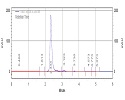
Comparison of L-Dopa content in three species of genus Mucuna by differente techniques
Abstract
Keywords
Full Text:
PDFReferences
Arulmozhi, M., and K. Janardhanan. “The Biochemical Composition and Nutritional Potential of The Tribal Pulse, Mucuna monosperma DC ex Wightii.” Plant Food for Human Nutrition 42. 1 (1992): 45–53.
http://www.chromacademy.com/hplc-training.html
https://www.ich.org/fileadmin/Public_Web_Site/ICH_Products/Guidelines/Quality/Q2_R1/Step4/Q2_R1__Guideline.pdf
Kasture, Veena, Vijay Sonar, Poonam Patil, and Deepak Musmade. “Quantitative Estimation of L-DOPA from Polyhebal Formulation by using RP-HPLC.” American Journal of Pharmtech Research 4.3 (2014): 408–414.
Katzenschlager, R, A. Evans, A Manson, P.N. Patsalos, N. Ratnaraj, H. Watt, L. Timmermann,R. Van der Giessen, and A.J. Lees. “Mucuna pruriens In Parkinson’s Disease: A Double Blindclinical and Pharmacological Study.” Journal of Neurology, Neurosurgery, and Psychiatry 75.12 (2004): 1672–1677.
Manyam, B.V., M. Dhansekaran, and T.A. Hare. “Neuroprotective Effects of the Antiparkinson Drug Mucuna pruriens.” Phytotherapy Research 18 (2004): 706.
Misra, L, and H. Wagner. “Extraction of Bioactive Principles from Mucuna Pruriens Seeds.” Indian Journal of Biochemistry and Biophysics 44 (2014): 56–60.
Poornachandra, M.N., S. Khanum, B.G. Shivanada, T.N. Shivanada, and R. Dris. “Mucuna pruriens (L) DC - A Novel Drug for Learning and Memory Retrieval.” Journal of Food, Agriculture and Environment 3 (2005): 13.
Pugalenthi, M, V. Vadivel, P. Gurumoorthi and K. Janardhanan. “Nutritional Potential of an Under-Exploited Legume, Mucuna monosperma DC ex Wight.” Indian Journal of Agricultural Biochemistry 16 (2003): 73–78
Raina, A.P., and R. Khatri. “Quantitative Determination of L-DOPA in Seeds of Mucuna pruriens Germplasm by High Performance Thin Layer Chromatography.” Indian Journal of Pharmaceutical Sciences 73.4 (2011) L: 459–462.
Ramya, K.B., and S. Thaakur. “Herbs Containing L- DOPA: An Update.” Ancient Science of Life 27.1 (2007): 50–55.
Rathod, B.G., and N.M. Patel. “Development of Validated Rp-Hplc Method for The Estimation of L-DOPA from Mucuna pruriens, Its Extracts and In Aphrodisiac Formulation.” International Journal of Pharmaceutical Science and Research 5 (2014): 508–513.
Sharma P.C., M.B. Yelne, and T.J. Dennis. “Data Base on Medicinal Plants Used in Ayurveda.” Central Council for Research in Ayurveda and Siddha 1 (2000): 200–203.
Simuni T., and H. Hurtig. “Levodopa: Pharmacologic Miracle Four Decades Later. In: Factor SA, Parkinson's Disease-Diagnosis and Clinical Management”. Weiner WJ (eds). Demos, New York, (2008): 471–490.
Takashi H., I. Takahashi, K. SaijoMasaaki, F. Tomohide, N. Tomoko, M. Yuji. “Quantitative Determination of L-DOPA in Dietary Supplements Containing Mucuna pruriens by High Performance Liquid Chromatography” Chiba Prefecture Wei Yan Annual Report 60 (2011): 53–56.
Tse G.G., B.B. Kim, A.M. McMurtray, and B.K. Nakamoto. “Case of Levodopa Toxicity from Ingestion of Mucuna gigantean.” Hawaii Journal of Medicine and Public Health 72.5 (2013): 157–160.
Vachhani U.D., M. Trivedi, A. Bajaj, C.P. Shah. “A HPTLC Method for Quantitative Estimation of L-DOPA from Mucuna pruriens in Polyherbal Aphrodisiac Formulation.” Research Journal of Pharmaceutical, Biological and Chemical Sciences 2.2 (2011): 389.
Vaidya A.B., T.G. Rajagopalan, N.A. Mankodi, D.S. Antarkar, P.S. Tathed, A.V. Purohit and N.H. Wadia. “Treatment of Parkinson's Disease with the Cowhage Plant-Mucuna pruriens Bak.” Neurology India 26.4 (1978): 171–6.
DOI: https://doi.org/10.21746/aps.2018.7.1.10
Copyright (c) 2018 Annals of Plant Sciences

This work is licensed under a Creative Commons Attribution-NonCommercial-NoDerivatives 4.0 International License.


